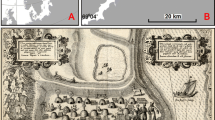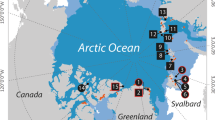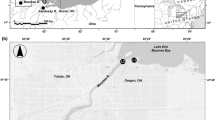Abstract
The stock of the European eel is considered to be outside safe biological limits, following a dramatic demographic decline in recent decades (90–99% drop) that involves a large number of factors including overfishing, contaminants and environmental fluctuations. The aim of the present study is to estimate the effective population size of the European eel and the possible existence of a genetic bottleneck, which is expected during or after a severe demographic crash. Using a panel of 22 EST-derived microsatellite loci, we found no evidence for a genetic bottleneck in the European eel as our data showed moderate to high levels of genetic diversity, no loss of allele size range or rare alleles, and a stationary population with growth values not statistically different from zero, which is confirmed by finding comparable value of short-term and long-term effective population size. Our results suggest that the observed demographic decline in the European eel did not entail a genetic decline of the same magnitude. Forward-time simulations confirmed that large exploited marine fish populations can undergo genetic bottleneck episodes and experience a loss of genetic variability. Simulations indicated that the failure to pick up the signal of a genetic bottleneck in the European eel is not due to lack of power. Although anthropogenic factors lowered the continental stock biomass, the observation of a stable genetic effective population size suggests that the eel crash was not due to a reduction in spawning stock abundance. Alternatively, we propose that overfishing, pollution and/or parasites might have affected individual fitness and fecundity, leading to an impoverished spawning stock that may fail to produce enough good quality eggs. A reduced reproduction success due to poor quality of the spawners may be exacerbated by oceanic processes inducing changes in primary production in the Sargasso Sea and/or pathway of transport across the Atlantic Ocean leading to a higher larval mortality.
Similar content being viewed by others
References
Allendorf FW, England PR, Luikart G, Ritchie PA, Ryman N (2008) Genetic effects of harvest on wild animal populations. Trends Ecol Evol 23:327–337
Anderson EC, Garza JC (2009) Estimation of population size with molecular genetic data. NOAA Tech. Mem. NMFS-SWFSC-448
Andrello M, Bevacqua D, Maes GE, De Leo GA (2010) An integrated genetic-demographic model to unravel the origin of genetic-structure in European eel (Anguilla anguilla). Evol Appl. doi:10.1111/j.1752-4571.2010.00167.x
Antao T, Lopes A, Lopes RJ, Beja-Pereira A, Luikart G (2008) LOSITAN—a workbench to detect molecular adaptation based on a FST-outlier method. BMC Bioinform 9:323
Ashley MV, Wilson MF, Pergams ORW, O’Dowd DJ, Gende SM, Brown JS (2003) Evolutionarily enlightened management. Biol Conserv 111:115–123
Beaumont MA (1999) Detecting population expansion and decline using microsatellites. Genetics 153:2013–2029
Beerli P, Felsenstein J (2001) Maximum likelihood estimation of a migration matrix and population effective sizes in n subpopulations using a coalescent approach. Proc Natl Acad Sci USA 98:4563–4568
Belkhir K, Borsa P, Chikhi L, Raufaste N, Bonhomme F (1996–2004) GENETIX 4.05, logiciel sous Windows TM pour la génétique des populations. Laboratoire Génome, Populations, Interactions, CNRS UMR 5000, Université de Montpellier II, Montpellier (France)
Belpaire C, Goemans G, Geeraerts C, Quataert P, Parmentier K, Hagel P, de Boer J (2009) Decreasing eel stocks: survival of the fattest? Ecol Freshw Fish 18:197–214
Bevacqua D, De Leo GA, Gatto M, Melià M, Crivelli AJ (2009) A long term study on eel population in the Camargue lagoon, Southern France. Presented to “Workshop on Eel in Saline Waters”, 4–7 Sep 2009, University of Göteborg, Sweden
Bonhommeau S, Chassot E, Rivot E (2008) Fluctuations in European eel (Anguilla anguilla) recruitment resulting from environmental changes in the Sargasso Sea. Fish Oceanogr 17:32–44
Chikhi L, Sousa VC, Luisi P, Goossens B, Beaumont MA (2010) The confounding effects of population structure, genetic diversity and the sampling scheme on the detection and quantification of population size changes. Genetics (in press) doi:10.1534/genetics.110.118661
Cornuet JM, Luikart G (1996) Description and power analysis of two tests for detecting recent population bottlenecks from allele frequency data. Genetics 144:2001–2014
Dannewitz J, Maes GE, Johansson L, Wickström H, Volckaert FAM, Jarvi T (2005) Panmixia in the European eel: a matter of time. Proc R Soc Lond B Biol Sci 272:1129–1137
Dekker W (2000) A Procrustean assessment of the European eel stock. ICES J Mar Sci 57:938–947
Dekker W (2003) Did lack of spawners cause the collapse of the European eel Anguilla anguilla? Fish Manage Ecol 10:365–376
Di Rienzo A, Peterson AC, Garza JC, Valdes AM, Slatkin M, Freimer NB (1994) Mutational processes of single-sequence repeat loci in human populations. Proc Natl Acad Sci USA 91:3166–3170
ICES (2008) Report of the Working Group on Eels (WGEEL), 3–9 September 2008, Leuven, Belgium. ICES CM 2008/ACFM:15, International Council for the Exploration of the Seas, Copenhagen, Denmark
ICES (2009) Report of the Working Group on Eels (WGEEL), 7–12 September 2009, Göteborg, Sweden. ICES CM 2009/ACFM:xx, International Council for the Exploration of the Seas, Copenhagen, Denmark
Frankham R (1995) Conservation genetics. Annu Rev Genet 29:305–327
Franklin JR (1980) Evolutionary change in small populations. In: Soulé ME, Wilcox BA (eds) Conservation biology: an evolutionary-ecological perspective. Sinuer, Sunderland, pp 135–150
Fraser DJ, Hansen MM, Ostergaard S, Tessier N, Legault M, Bernatchez L (2007) Comparative estimation of effective population sizes and temporal gene flow in two contracting population systems. Mol Ecol 16:3866–3889
Friedland KD, Miller MI, Knights B (2007) Oceanic changes in the Sargasso Sea and declines in recruitment of the European eel. ICES J Mar Sci 64:519–530
Garza JC, Williamson EG (2001) Detection of reduction in population size using data from microsatellite loci. Mol Ecol 10:305–318
Goudet J (2002) FSTAT version 2.9.3.2. Available from: http://www2.unil.ch/popgen/softwares/fstat.htm
Guinand B, Scribner KT (2003) Evaluation of methodology for detection of genetic bottlenecks: inferences from temporally replicated lake trout populations. C R Biol 326:S61–S67
Hauser L, Carvalho GR (2008) Paradigm shifts in marine fisheries genetics: ugly hypotheses slain by beautiful facts. Fish Fish 9:333–362
Hauser L, Adcock GJ, Smith PJ, Bernal Ramirez JH, Carvalho GR (2002) Loss of microsatellite diversity and low effective population size in an overexploited population of New Zealand snapper (Pagrus auratus). Proc Natl Acad Sci USA 99:11742–11747
Hedgecock D (1994) Does variance in reproductive success limit effective population sizes of marine organisms? In: Beaumont AR (ed) Genetics and evolution of aquatic organisms. Chapman and Hall, London, pp 122–134
Hendrick P (2005) Large variance in reproductive success and the N e /N ratio. Evolution 59:1596–1599
Hendry AP, Kinnison MT (1999) The pace of modern life: measuring rates of contemporary microevolution. Evolution 53:1637–1653
Hoarau G, Boon E, Jongma DN, Ferber S, Rijnsdorp AD, Palsson J, Van der Veer HW, Stam WT, Olsen JL (2005) Low effective population size and evidence for inbreeding in a commercially overexploited flatfish: plaice (Pleuronectes platessa). Proc R Soc Lond B 272:497–503
Hutchinson WF, Van Oosterhout C, Rogers SI, Carvalho GR (2003) Temporal analysis of archived samples indicates marked genetic changes in declining North Sea cod (Gadus morhua). Proc R Soc Lond B 270:2125–2132
Jorde PE, Ryman N (1995) Temporal allele frequency change and estimation of effective size in populations with overlapping generations. Genetics 139:1077–1090
Jorde PE, Ryman N (1996) Demographic genetics of brown trout (Salmo trutta) and estimation of effective population size from temporal change of allele frequencies. Genetics 143:1369–1381
Kauer MO, Dieringer D, Schlötterer C (2003) A microsatellite variability screen for positive selection associated with the “out of Africa” habitat expansion of Drosophila melanogaster. Genetics 165:1137–1148
Knights B (2003) A review of the possible impacts of long-term oceanic and climate changes and fishing mortality on recruitment of anguillid eels of the Northern hemisphere. Sci Total Environ 310:237–244
Kuhner MK (2006) LAMARC 2.0:maximum likelihood and Bayesian estimation of population parameters. Bioinformatics 22:768–770
Lande R (1988) Genetics and demography in biological conservation. Science 241:1455–1460
Luikart G, Sherwin WB, Steele BM, Allendorf FW (1998) Usefulness of molecular markers for detecting population bottlenecks via monitoring genetic change. Mol Ecol 7:963–974
Luikart G, Ryman N, Tallmon DA, Schwartz MK, Allendorf FW (2010) Estimating census and effective population sizes: increasing usefulness of genetic methods. Conserv Genet 11:355–373
Lynch M, Lande R (1998) The critical effective population size for a genetically secure population. Anim Conserv 1:70–72
Maes GE, Pujolar JM, Hellemans B, Volckaert FAM (2007) Evidence for isolation by time in the European eel (Anguilla anguilla). Mol Ecol 15:2095–2107
McCleave JD (1993) Physical and behavioral controls on the oceanic distribution and migration of leptocephali. J Fish Biol 43:243–273
Ohta T, Kimura M (1973) A model of mutation appropriate to estimate the number of electrophoretically detectable alleles in a genetic population. Genet Res 22:201–204
Palm S, Dannewitz J, Prestegaard T, Wickström H (2009) Panmixia in the European eel revisited: no genetic difference between maturing adults from southern and northern Europe. Heredity 103:82–89
Palstra FP, Ruzzante DE (2008) Genetic estimates of contemporary effective population size: what can they tell us about the importance of genetic stochasticity for wild population persistence? Mol Ecol 17:3428–3447
Palstra AP, Van Ginneken VJT, Murk AJ, Van den Thillart G (2006) Are dioxin-like contaminants responsible for the eel Anguilla anguilla drama? Naturwissenschaften 93:145–148
Peng B, Amos CI (2008) Forward-time simulations and non-random mating using SIMUPOP. Bioinformatics 24:1408–1409
Piry SG, Luikart G, Cornuet JM (1999) BOTTLENECK: a computer program for detecting recent reductions in the effective population size using allele frequency data. J Hered 90:502–503
Pollak E (1983) A new method for estimating the effective population size from allele frequency changes. Genetics 104:531–548
Pujolar JM, Maes GE, Volckaert FAM (2006) Genetic patchiness among recruits of the European eel Anguilla anguilla. Mar Ecol Prog Ser 307:209–217
Pujolar JM, Maes GE, Volckaert FAM (2007) Genetic and morphometric heterogeneity among recruits of the European eel Anguilla anguilla. Bull Mar Sci 81:297–308
Pujolar JM, Ciccotti E, De Leo GA, Zane L (2009a) Genetic composition of Atlantic and Mediterranean recruits of the European eel (Anguilla anguilla) based on EST-linked microsatellite. J Fish Biol 74:2034–2046
Pujolar JM, Maes GE, Van Hoedt JKJ, Zane L (2009b) Isolation and characterization of EST-linked microsatellite loci for the European eel, Anguilla anguilla. Mol Ecol Res 9:233–235
Rambaut A, Drummond AJ (2007) Tracer version 1.4. Available from http://beast.bio.ed.ac.uk/Tracer
Raymond M, Rousset F (1995) GENEPOP (version 1.2): a population genetics software for exact tests and ecumenicism. J Hered 86:248–249
Rice WR (1989) Analyzing tables and statistical tests. Evolution 43:223–225
Robinet TT, Feunteun E (2002) Sublethal effects of exposure to chemical compounds: a cause for the decline in Atlantic eels? Ecotoxicology 11:265–277
Ruzzante DE, Taggart CT, Doyle RW, Cook D (2001) Stability in the historical pattern of genetic structure of Newfoundland cod (Gadus morhua) despite the catastrophic decline in population size from 1964 to 1994. Conserv Genet 2:257–269
Schlötterer C (2003) A microsatellite-based multilocus screen for the identification of local selective sweeps. Genetics 160:753–763
Sokal RR, Rohlf FJ (1995) Biometry: the principles and practice of statistics in biological research. Freeman and Co, New York
Stockwell CA, Ashley MV (2003) Rapid adaptation and conservation. Conserv Biol 18:272–273
Stockwell CA, Hendry AP, Kinnison MT (2003) Contemporary evolution meets conservation biology. Trends Ecol Evol 18:94–101
Taylor AC, Sherwin WB, Wayne RK (1994) Genetic variation of microsatellite loci in a bottlenecked species: the northern hairy-nosed wombat, Lasiorhinus krefftii. Mol Ecol 3:277–290
Van den Thillart G, Rankin JC, Dufour S (2009) Spawning migration of the European eel: reproduction index, a useful tool for conservation management. Springer, Dordecht
Van Oosterhout CV, Hutchinson WF, Wills DPM, Shipley P (2004) Micro-checker: software for identifying and correcting genotyping errors in microsatellite data. Mol Ecol 4:535–538
Vøllestad LA (1992) Geographic variation in age and length at metamorphosis of maturing European eel: environmental effects and phenotypic plasticity. J Anim Ecol 61:41–48
Wirth T, Bernatchez L (2003) Decline of North Atlantic eels: a fatal synergy? Proc R Soc Lond B 270:681–688
Acknowledgments
This work has been funded by an Italian Research Program grant to LZ and by the University of Padova grant CPDA 085158/08 to LZ. We thank the CNR Lesina, the Parco Nazionale del Circeo and the Tiber fishers for support in sampling.
Author information
Authors and Affiliations
Corresponding author
Electronic supplementary material
Below is the link to the electronic supplementary material.
Rights and permissions
About this article
Cite this article
Pujolar, J.M., Bevacqua, D., Capoccioni, F. et al. No apparent genetic bottleneck in the demographically declining European eel using molecular genetics and forward-time simulations. Conserv Genet 12, 813–825 (2011). https://doi.org/10.1007/s10592-011-0188-y
Received:
Accepted:
Published:
Issue Date:
DOI: https://doi.org/10.1007/s10592-011-0188-y




